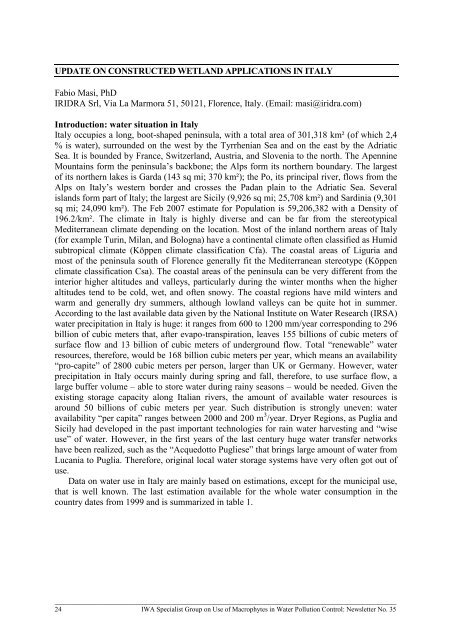Specialist Group on Use of Macrophytes in Water Pollution ... - IWA
Specialist Group on Use of Macrophytes in Water Pollution ... - IWA
Specialist Group on Use of Macrophytes in Water Pollution ... - IWA
You also want an ePaper? Increase the reach of your titles
YUMPU automatically turns print PDFs into web optimized ePapers that Google loves.
UPDATE ON CONSTRUCTED WETLAND APPLICATIONS IN ITALY<br />
Fabio Masi, PhD<br />
IRIDRA Srl, Via La Marmora 51, 50121, Florence, Italy. (Email: masi@iridra.com)<br />
Introducti<strong>on</strong>: water situati<strong>on</strong> <strong>in</strong> Italy<br />
Italy occupies a l<strong>on</strong>g, boot-shaped pen<strong>in</strong>sula, with a total area <strong>of</strong> 301,318 km² (<strong>of</strong> which 2,4<br />
% is water), surrounded <strong>on</strong> the west by the Tyrrhenian Sea and <strong>on</strong> the east by the Adriatic<br />
Sea. It is bounded by France, Switzerland, Austria, and Slovenia to the north. The Apenn<strong>in</strong>e<br />
Mounta<strong>in</strong>s form the pen<strong>in</strong>sula‘s backb<strong>on</strong>e; the Alps form its northern boundary. The largest<br />
<strong>of</strong> its northern lakes is Garda (143 sq mi; 370 km²); the Po, its pr<strong>in</strong>cipal river, flows from the<br />
Alps <strong>on</strong> Italy‘s western border and crosses the Padan pla<strong>in</strong> to the Adriatic Sea. Several<br />
islands form part <strong>of</strong> Italy; the largest are Sicily (9,926 sq mi; 25,708 km²) and Sard<strong>in</strong>ia (9,301<br />
sq mi; 24,090 km²). The Feb 2007 estimate for Populati<strong>on</strong> is 59,206,382 with a Density <strong>of</strong><br />
196.2/km². The climate <strong>in</strong> Italy is highly diverse and can be far from the stereotypical<br />
Mediterranean climate depend<strong>in</strong>g <strong>on</strong> the locati<strong>on</strong>. Most <strong>of</strong> the <strong>in</strong>land northern areas <strong>of</strong> Italy<br />
(for example Tur<strong>in</strong>, Milan, and Bologna) have a c<strong>on</strong>t<strong>in</strong>ental climate <strong>of</strong>ten classified as Humid<br />
subtropical climate (Köppen climate classificati<strong>on</strong> Cfa). The coastal areas <strong>of</strong> Liguria and<br />
most <strong>of</strong> the pen<strong>in</strong>sula south <strong>of</strong> Florence generally fit the Mediterranean stereotype (Köppen<br />
climate classificati<strong>on</strong> Csa). The coastal areas <strong>of</strong> the pen<strong>in</strong>sula can be very different from the<br />
<strong>in</strong>terior higher altitudes and valleys, particularly dur<strong>in</strong>g the w<strong>in</strong>ter m<strong>on</strong>ths when the higher<br />
altitudes tend to be cold, wet, and <strong>of</strong>ten snowy. The coastal regi<strong>on</strong>s have mild w<strong>in</strong>ters and<br />
warm and generally dry summers, although lowland valleys can be quite hot <strong>in</strong> summer.<br />
Accord<strong>in</strong>g to the last available data given by the Nati<strong>on</strong>al Institute <strong>on</strong> <strong>Water</strong> Research (IRSA)<br />
water precipitati<strong>on</strong> <strong>in</strong> Italy is huge: it ranges from 600 to 1200 mm/year corresp<strong>on</strong>d<strong>in</strong>g to 296<br />
billi<strong>on</strong> <strong>of</strong> cubic meters that, after evapo-transpirati<strong>on</strong>, leaves 155 billi<strong>on</strong>s <strong>of</strong> cubic meters <strong>of</strong><br />
surface flow and 13 billi<strong>on</strong> <strong>of</strong> cubic meters <strong>of</strong> underground flow. Total ―renewable‖ water<br />
resources, therefore, would be 168 billi<strong>on</strong> cubic meters per year, which means an availability<br />
―pro-capite‖ <strong>of</strong> 2800 cubic meters per pers<strong>on</strong>, larger than UK or Germany. However, water<br />
precipitati<strong>on</strong> <strong>in</strong> Italy occurs ma<strong>in</strong>ly dur<strong>in</strong>g spr<strong>in</strong>g and fall, therefore, to use surface flow, a<br />
large buffer volume – able to store water dur<strong>in</strong>g ra<strong>in</strong>y seas<strong>on</strong>s – would be needed. Given the<br />
exist<strong>in</strong>g storage capacity al<strong>on</strong>g Italian rivers, the amount <strong>of</strong> available water resources is<br />
around 50 billi<strong>on</strong>s <strong>of</strong> cubic meters per year. Such distributi<strong>on</strong> is str<strong>on</strong>gly uneven: water<br />
availability ―per capita‖ ranges between 2000 and 200 m 3 /year. Dryer Regi<strong>on</strong>s, as Puglia and<br />
Sicily had developed <strong>in</strong> the past important technologies for ra<strong>in</strong> water harvest<strong>in</strong>g and ―wise<br />
use‖ <strong>of</strong> water. However, <strong>in</strong> the first years <strong>of</strong> the last century huge water transfer networks<br />
have been realized, such as the ―Acquedotto Pugliese‖ that br<strong>in</strong>gs large amount <strong>of</strong> water from<br />
Lucania to Puglia. Therefore, orig<strong>in</strong>al local water storage systems have very <strong>of</strong>ten got out <strong>of</strong><br />
use.<br />
Data <strong>on</strong> water use <strong>in</strong> Italy are ma<strong>in</strong>ly based <strong>on</strong> estimati<strong>on</strong>s, except for the municipal use,<br />
that is well known. The last estimati<strong>on</strong> available for the whole water c<strong>on</strong>sumpti<strong>on</strong> <strong>in</strong> the<br />
country dates from 1999 and is summarized <strong>in</strong> table 1.<br />
___________________________________________________________________________<br />
24 <strong>IWA</strong> <str<strong>on</strong>g>Specialist</str<strong>on</strong>g> <str<strong>on</strong>g>Group</str<strong>on</strong>g> <strong>on</strong> <strong>Use</strong> <strong>of</strong> <strong>Macrophytes</strong> <strong>in</strong> <strong>Water</strong> Polluti<strong>on</strong> C<strong>on</strong>trol: Newsletter No. 35


